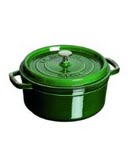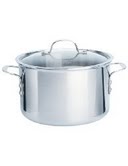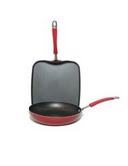What is the Safest (Non-Toxic) Cookware?
You may be strict with organic ingredients and veggies. But if your pots and pans are not as green as the food, the results might not be healthy and waste your money. Many cookware products contain dangerous metals and chemicals, which are about as harmful as they sound. Here, we bring all you need to know about safe and eco-friendly gears for your kitchens.
When Material Matters
Many of us may understand that only new type of greener cookware, such as
Cuisinart GreenGourmet, is a safe alternative; however, some traditional materials are safe, too. Learn them below.
| |
|
SUPERIOR
|
- Glass and Clay. According from FDA, this is a most safe tool for no-leached and no-reactive harmful chemicals and lead. However, it can shatter when having extremely temperature changes. Moreover, as poor heat distribution, glassware is good for specifically uses, such as baking but not for stovetop burning.
- Bamboo. Steamers and paddles as well as wooden spoons, chopsticks and crockery are totally non-reactive and considered to have no dangerous effects on food during cooking. Bamboo steamers are dishwasher safe, and bamboo is also an earth-friendly and renewable resource.
- Silicone is non-reactive, FDA approved and safe up to 428 degrees F (Most bakeware has 500 degree F heat resistance). If heated above its safe range, silicone melts but doesn’t outgas toxic gas. The advantages of silicone include heat resistance, flexibility, which can go directly from the oven or microwave into the refrigerator or freezer, and easy to clean.
Even so, the expert said it’s possible that very small amounts of leached silicone oil could get on food and our skins.
- Enamel Cast-Iron. Proper-made enamel-coated cast steel is safe to cook and features excellent cooking performance. According to the FDA’s Center for Food Safety and Applied Nutrition, because of the high firing temperatures required, lead which could present a safety concern isn’t used in the enamel for these pots and pans. Yet, enamelware is non-reactive as long as the enamel is not scratched or chipped.
Le Crueset and staub are the pro for this type of pot. It’s comparatively expensive than normal cast iron, however, a 5.5-quart Dutch oven or 12” skillet won’t make regret. As nonstick and non-seasoning feature, it’s a truly favorite for many named Chefs, such as Mario Batali.
- Ceramic-based Coat. As being 100% PFOA- and PTFE-free nonstick, new technologies on ceramic cookware are spotlight these days. From the fact that Dupont’s announcement of phasing out PFOAs in the cookware by 2015 and the coming of eco-friendly consciousness, many brands have stepped into the newly come innovation of nonstick based on ceramic. The popular nano technologies of ceramic-based coats, for examples, are Ceramica (Cuisinart), Thermolon (GreenPan, J.A. Zwilling) and Sand Flow (EarthPan). Like other coated cookware, ceramic is safe on condition that the coat doesn’t breakup.
Note that: Nevertheless, the ceramic-based or enameled cookware mentioned above doesn’t include ceramic or enameled cookware, such as some dishes or tableware, which are most used for decoration. These glazing products contain highly toxic substances, such as lead or cadmium. For safer uses, follow the instruction labels; if it says NOT for food, DO NOT put food in it.
|
| |
|
GOOD

|
- Cast Iron is another healthy alternative to non-stick cooking surfaces. Cast iron can withstand high heat, superior heat distribution and absorption than most types of materials. Also, it’s extremely durable and can be purchased pre-seasoned and ready to use.
Though this material is concerned as a safe nonstick-like tool, it supposes to cause inorganic iron leach into the food that probably is risky for iron-overloaded people. However, the amount of iron the food is in safe level for most people, said the WCA experts.
- Stainless-Steel. Unlike nonstick pan, stainless browns food better. However, the safe of using this cookware depends on the quality of craft. As this alloy is combination of iron, nickel and chromium. Typically, stainless steel is categorized as non-reactive cookware, which has very few possible contaminations in foods.
The 18/10 ratio tells that it consist of 18% chromium and 10% nickel. If you are allergic to nickel try less nickel ratio, for examples, 18/8 or 18/0. Read more about the safe of uses issue of stainless cookware.
- Hard-Anodized Aluminum has been treated to develop an aluminum oxide (extremely hard and non-reactive) coating on the surface of the cookware or “locks in” the aluminum inside. Anodized aluminum tools don’t react to acidic foods and safe enough for cooking sauces with tomato, wine, and lemon juice. However, once the surface chips or peels, it potentially becomes reactive. From this point, the quality of this type of cookware plays the big roles.
- Titanium is non-reactive and lightweight but a poor heat conductor. So, typically what is labeled titanium cookware is actually aluminum tools that has a fused ceramic-titanium, nonstick coating. It’s expensive, but durable and a healthful, nonreactive choice and good choice for camping cookware.
|
| |
|
POOR

|
- Copper itself can is reactive and can emit to food. FDA has cautioned about the use of copper utensils from Copperiedus, or copper toxicity. Unlined copper cookware can leach into foods when cooking, so many countries and states have restricted the sale of these products.
Since copper is superbly heat conductivity, many brands have used inside the cookware by ‘Clad’ or wrapped by other safe alloys (mostly stainless steel) for making better performance and non-reactive cookware.
- Aluminum. Plain aluminum is low-cost, light-weight, and thermally responsive—but reactive. Foods cooked in aluminum can react with the metal to form aluminum salts associated with impaired visual motor coordination and Alzheimer’s disease. However, there is no definite evident proven and more than half of all cookware sold today is made of aluminum. For better alternative, stepping to hard-anodized aluminum or clad stainless instead.
- Teflon & Poor Nonstick. As containing plastic polymers (silicon is the one exception). The surface of the original nonstick cookware, Teflon, was coated with the synthetic resin. According by The Environmental Protection Agency (EPA), the Perfluorooctanoic Acid (PFOA) and Polytetrafluorethylene (PTFE) are the major dangerous as they will release the toxic fumes which create a considerable health hazard when heating over 500 degree F.
However, with proper use and care, this type of material—which has been used more than half of all cookware in the US—should be safe to use for years to come.
- Plastic. The more flexible a plastic, the more it is reactive. Thus plastic wrap more quickly exchanges synthetic ions with food than does a flexible milk jug; and the latter is more reactive than a sturdy plastic container. Incidentally, the PVC is typically found in plastic wrap leaches a hormone-disrupting toxin, DEAH, into the surface layers of food. Additionally, PVC contains phthalates which accumulate in body tissues and damage the liver and lungs; it migration from plastic wrap is increased by mechanical stress solvents such as fats, oils, saliva, and temperatures over 85°F.
Note That: Even though these materials are considered as the ‘at-risk’ choices, the food-safety experts include FDA, do not refuse the uses. On the other hands, these poor types are concerned to use with cautions, which are appropriate temperature, proper maintenance and some certain kinds of foods.
|